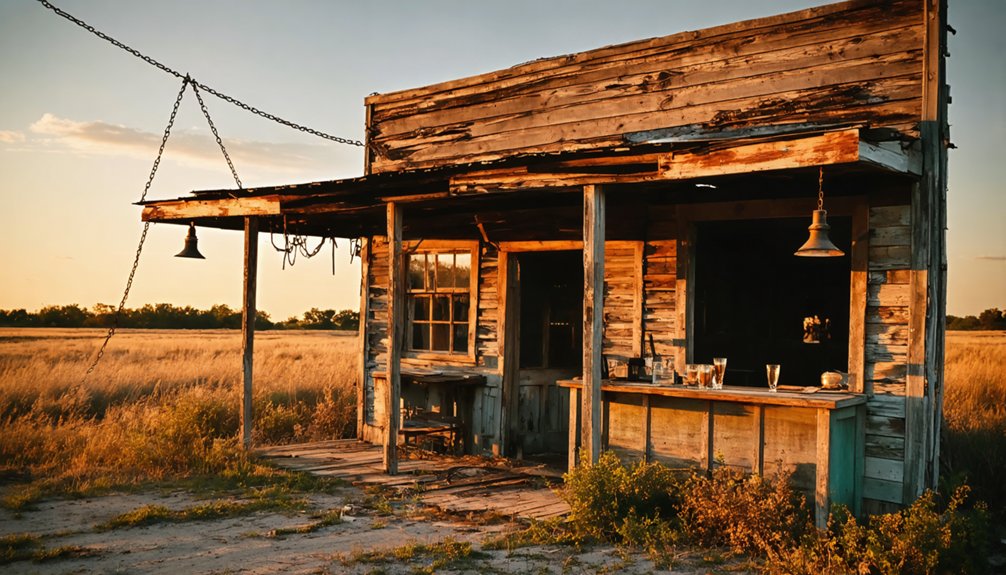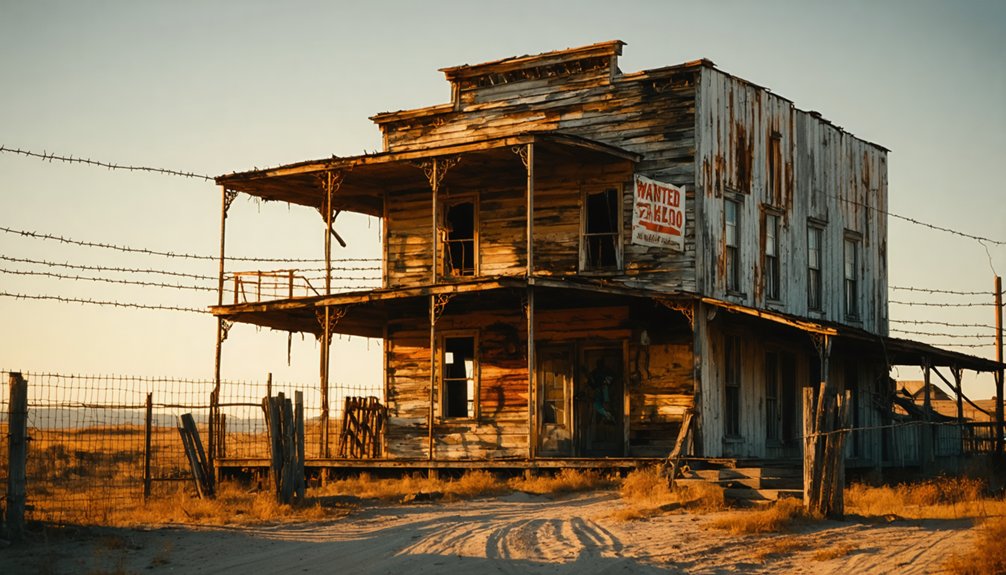Colorado’s mountains harbor over 640 ghost towns, remnants of the 1858 gold rush that transformed the landscape. You’ll find eerie abandoned structures at St. Elmo, where 40 original buildings remain, or Ashcroft, which boomed to 2,000 residents before collapsing. These high-altitude settlements (some above 11,000 feet) faced brutal winters, avalanches, and economic uncertainty before their sudden abandonment. Each decaying headframe and weathered saloon tells a story of fortune, failure, and forgotten dreams.
Key Takeaways
- Colorado has over 640 visible ghost town sites, remnants of the mining boom that followed the 1858 Pike’s Peak Gold Rush.
- St. Elmo is one of the best-preserved ghost towns with 40 original structures from the 1880s mining era.
- Extreme conditions at elevations above 11,000 feet led to high mortality rates and seasonal abandonment of mining settlements.
- Abandoned mines created lasting environmental hazards, with toxic drainage and structural dangers persisting at hundreds of sites.
- Tourism now transforms these eerie abandoned settlements into outdoor museums funded by entry fees and guided tours.
The Gold Rush Era: How Colorado’s Ghost Towns Were Born
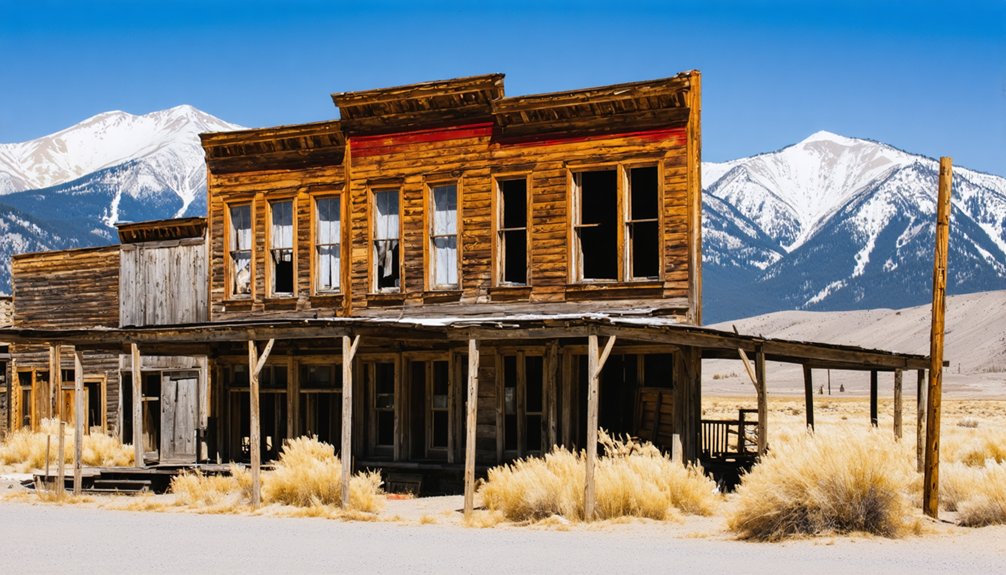
When the cry of “Gold!” echoed across the nation in the summer of 1858, it sparked what would officially become known as the Pike’s Peak Gold Rush, forever altering Colorado’s landscape and destiny.
You can trace the ghost town origins to those early settlements established in 1859, following George Jackson’s pivotal discovery at present-day Idaho Springs and John Gregory’s legendary finding near Central City.
Despite mining settlement challenges of extreme terrain and brutal Rocky Mountain winters, prospectors pushed deep into seemingly impossible landscapes, establishing over 500 mines and countless high-altitude camps.
Undeterred by nature’s harshest obstacles, miners conquered Colorado’s forbidding peaks, forever leaving their mark on the mountainous frontier.
These settlements followed a predictable pattern—explosive growth during initial discoveries, followed by rapid decline as accessible gold disappeared.
While some evolved into supply centers, many transformed into the haunting abandoned structures you’ll find scattered throughout Colorado’s mountains today, including the once-thriving City of Gold Mines that later became the ghost town of Victor.
The San Juan Mountains region was particularly difficult to develop, with slow development due to its extreme isolation and rugged terrain.
St. Elmo: Colorado’s Best-Preserved Mining Community
Among the faded remnants of Colorado’s mining legacy, St. Elmo stands as a time capsule frozen in the 1880s. With 40 original structures still standing, you’ll step into authentic mining-era life as you wander past the Town Hall, now a museum showcasing the town’s prosperous past.
St. Elmo’s architecture reflects the boom days when the Mary Murphy mine alone yielded 220,000 ounces of gold worth $4.4 million. The historical significance earned it a spot on the National Register of Historic Places in 1979.
Once home to 2,000 residents, five hotels, and countless saloons, St. Elmo thrived until fire and depleted ore triggered its decline. Originally named Forest City, the town was later renamed after a popular novel of the era. The Denver, South Park & Pacific Railroad established in 1881 was crucial for transporting mining supplies to the remote settlement.
Today, private owners and preservation organizations work together to maintain this remarkable window into Colorado’s mining heritage.
Abandoned Fortunes: The Rise and Fall of Ashcroft and Independence

Unlike St. Elmo, the twin ghosts of Ashcroft and Independence represent fortunes abandoned almost as quickly as they were found.
You’ll discover that Ashcroft boomed after 1880’s silver discoveries, growing to 2,000 residents with impressive mining infrastructure including a smelter, sawmills, and 20 saloons.
When Ashcroft’s shallow veins yielded their extraordinary 14,000-ounce-per-ton silver deposits, prosperity seemed assured.
But nature deceived the enthusiastic miners – the veins were merely surface deposits. By 1885, only 100 summer residents remained, the town treasury holding a mere $5.60.
Originally called Castle Forks City and then Chloride, the settlement was renamed Ashcroft in 1882 following rich ore strikes in the area.
Nearby Independence suffered a similar fate after its 1879 founding.
Both settlements withered as Aspen flourished.
Today, these ghost towns stand as monuments to freedom seekers who gambled everything on silver dreams that sparkled briefly before fading into Colorado’s rugged landscape. Visitors can explore the historical structures including log cabins and building foundations that offer glimpses into the daily life of early miners.
Henson: The $12 Million Boomtown That Vanished
Hidden beneath Colorado’s rugged peaks lies the remarkable story of Henson, a boomtown that extracted over $12 million in precious metals before vanishing into the mountainous landscape.
Named after early settler Henry Henson, the town flourished after the 1873 Brunot Treaty removed Ute Indians, opening a floodgate of mining innovation and prosperity.
Henson’s Legacy is preserved in three distinct chapters:
- The Boom (1871-1899) – From discovery to peak population of 300, complete with post office, schoolhouse, and thriving commerce. The town featured a distinctive area called Little Rome where Italian immigrants established their own community.
- The Struggle (1899-1913) – Labor strikes, shootings, and harsh conditions challenged residents’ pursuit of freedom.
- The Fade (1913-1973) – Gradual abandonment until the final hydroelectric dam failure marked its unofficial end. The dam break resulted in hundreds of fish deaths downstream due to chemical contamination.
Today, you’ll find restored structures and self-guided tours from May to December, where mining innovations once transformed raw landscape into fleeting fortune.
Life and Death in High-Altitude Mining Settlements
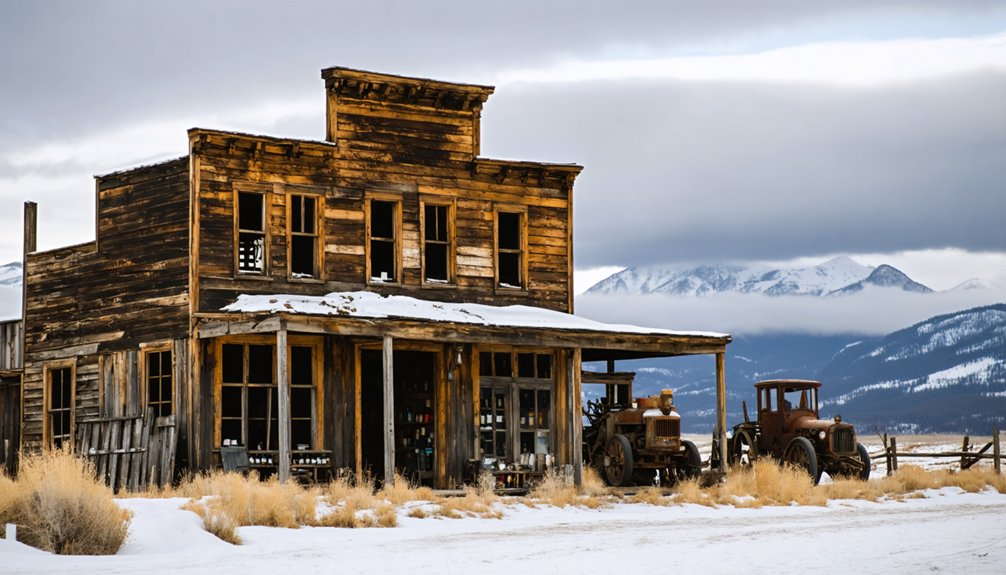
If you’d ventured to Colorado’s mining settlements in the 1880s, you’d have faced brutal winters at 11,000+ feet where temperatures plummeted to -30°F, while wagons navigated treacherous mountain passes to deliver basic supplies at exorbitant prices.
Despite these hardships, you might’ve witnessed astonishing prosperity during the boom years—silver and gold pouring from mountain veins, funding ornate opera houses and grand hotels where champagne flowed freely despite the isolation.
Your mental fortitude would’ve been tested by months of snowbound isolation when avalanches cut off entire communities, leading many miners to battle depression and alcoholism in these precariously perched towns where death from accident, disease, or suicide claimed lives at rates far exceeding those in lowland settlements. The Red Mountain District’s unique vertical ore chimneys yielded incredibly rich deposits containing up to 1,000 ounces of silver per ton, making the dangerous work worth the risk for many. By the 1870s, miners faced increasing dangers as mining operations became more mechanized and organized, requiring them to work deeper underground for low wages despite the substantial risks.
Harsh Weather Survival
While the promise of silver and gold lured thousands to Colorado’s mountain settlements, survival at elevations exceeding 10,900 feet presented challenges far deadlier than mining itself.
In these extreme conditions, you’d face not just the mountain’s wrath but your body’s own limitations.
Survival strategies became essential when:
- Oxygen deprivation constantly plagued residents, with immigrants from Eastern Europe and Scandinavia particularly struggling to adapt.
- Winter snowfall buried entire communities for 3-4 months, forcing seasonal evacuation to lower valleys.
- Avalanches claimed dozens of lives, including 8 miners in Telluride (1883) and 12 more in 1906.
You’d find yourself either abandoning these settlements during brutal winters or risking death in poorly constructed cabins while the mountain’s thin air slowly drained your strength.
Mining Boom Prosperity
As the glittering promise of silver and gold transformed Colorado’s barren mountainsides during the 1879-1893 boom, you’d witness entire communities materialize virtually overnight, perched precariously at elevations where breathing itself was a challenge.
You’d find Leadville’s streets bustling with newly-minted millionaires like Horace Tabor alongside thousands of laborers seeking mining riches in carbonate ores worth over $12 million annually. Railroad lines carved through impossible terrain, connecting isolated settlements to Denver’s markets. Opulent opera houses and hotels stood as monuments to newfound wealth.
Yet these prosperity cycles were fleeting. For every fortune made, countless miners endured deadly working conditions.
The economic house of cards collapsed when the Sherman Silver Purchase Act was repealed in 1893, sending silver prices plummeting. Towns that once boasted thousands emptied rapidly, leaving behind the silent structures we explore today.
Isolation’s Mental Toll
Perched above 10,000 feet where the air thins and winter winds howl through poorly insulated cabins for months on end, Colorado’s mining settlements harbored a darkness beyond their tunnels and shafts.
You’d find your mind challenged as much as your body in these remote outposts where psychological effects of isolation compounded daily physical struggles.
The mental toll manifested in:
- Chronic anxiety and depression from constant environmental threats
- Deepening despair as economic prospects waned and younger generations fled
- Collective trauma from mining accidents and environmental contamination
Yet community resilience emerged through shared hardship.
You’d witness neighbors creating support networks, organizing communal activities, and developing mutual aid systems.
Despite toxic legacies and economic uncertainty, these high-altitude communities forged bonds through their isolation—though even the strongest social fabric couldn’t fully shield them from the crushing weight of mountain solitude.
What Remains: Exploring Colorado’s 640 Visible Ghost Town Sites
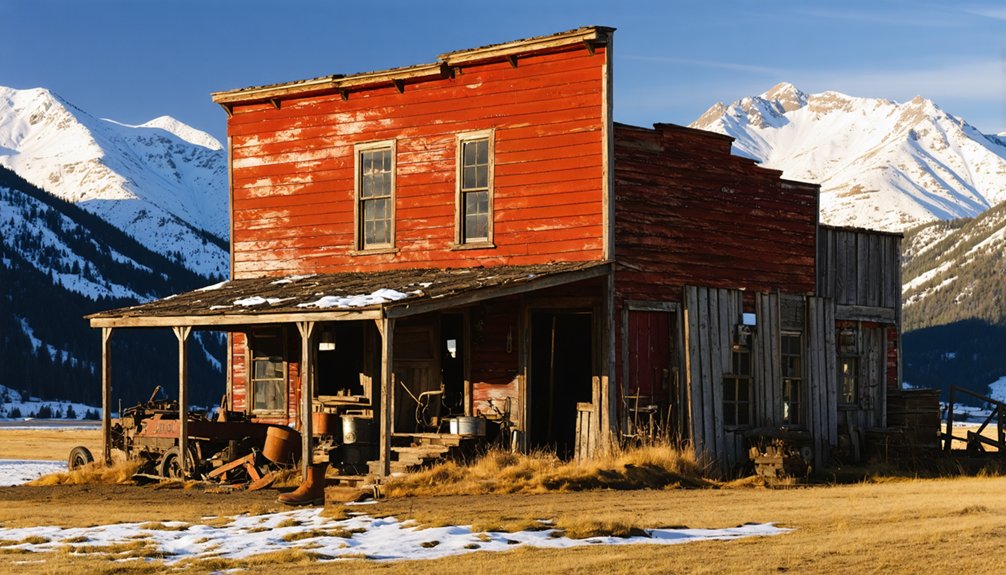
As you wander through Colorado’s hidden valleys and mountainsides, you’ll encounter massive stamp mills, rusting ore carts, and weathered headframes—silent sentinels marking where thousands once sought mineral fortunes.
These industrial remains tell stories of technological innovation and human perseverance against the harsh alpine conditions that challenged every mining operation established above 9,000 feet.
Tourism has breathed new economic life into sites like St. Elmo and Castle Dome, where preserved storefronts, saloons, and boardinghouses offer you an authentic glimpse into the brief but vibrant chapters of Colorado’s mining heritage.
Abandoned Mining Infrastructure
While Colorado’s ghost towns themselves tell stories of boom and bust, it’s the vast network of abandoned mining infrastructure that provides the most visceral connection to the state’s industrial past.
When you explore these sites, you’re witnessing the remnants of a staggering industrial footprint—over 23,000 abandoned mines dot the landscape, with countless abandoned structures slowly returning to the earth.
These sites present three stark realities:
- Environmental hazards persist at over 500 locations where acidic drainage contaminates roughly 1,800 miles of streams.
- Structural dangers lurk in deteriorating headframes, adits, and mill buildings.
- Toxic legacies remain in tailings piles containing arsenic, lead, and mercury.
Only about half of these sites have received any remediation, leaving a complex inheritance of both historical value and environmental burden.
Preservation Through Tourism
Colorado’s 640 visible ghost town sites represent the physical memory of a bygone era, each telling a unique story of frontier ambition and subsequent decline.
When you visit these relics, you’re participating in ghost town preservation through your footsteps and curiosity.
The tourism impact has transformed abandoned settlements into outdoor museums where you can freely wander among miners’ cabins, weathered saloons, and collapsing mills.
Places like Animas Forks and St. Elmo now feature interpretive signs, stabilized structures, and occasionally guided tours. Your entry fees and donations fund critical preservation efforts, helping these historic treasures withstand harsh mountain elements.
These ghost towns aren’t merely tourist attractions—they’re living connections to the immigrant communities and boom-bust economies that shaped Colorado’s identity, now protected through your interest in experiencing authentic frontier history.
Economic Collapse: How the Silver Crash Emptied Towns Overnight
The devastating repeal of the Sherman Silver Purchase Act in 1893 sent shockwaves through Colorado’s mining communities, triggering an economic collapse that would transform vibrant settlements into ghost towns almost overnight.
Silver prices plummeted by a third, forcing 90 mines in Leadville alone to close their doors and leaving 9,500 miners suddenly jobless.
You can still sense the economic devastation that exceeded even the Great Depression’s impact when you visit these abandoned towns:
- Mine closures that sent unemployment rates soaring to 40-50% in many communities
- Abandoned homes where mining families fled in search of survival elsewhere
- Empty rail yards where bustling transportation hubs fell silent
The crash sparked significant labor struggles while testing economic resilience as communities either diversified or disappeared forever.
Modern Tourism: Experiencing Colorado’s Mining Heritage Today

Today’s adventure seekers can step back in time as they explore Colorado’s once-thriving mining communities that now stand frozen in various states of picturesque decay.
You’ll discover remarkably preserved 19th-century cabins with original furnishings in Animas Forks, while Alta near Telluride showcases authentic mining-era structures on the National Register of Historic Places.
Access these ghost town experiences via high-clearance 4WD vehicles or guided Jeep tours that navigate the scenic Alpine Loop Drive.
Adventure awaits on the Alpine Loop, where history unfolds through guided Jeep tours and rugged 4WD excursions.
For immersive mining heritage tourism, visit the interactive exhibits at Vicksburg and Winfield, where audio guides narrate life in 1800s mining camps.
Explore safely during summer and early fall, as harsh winter conditions make these high-altitude sites treacherous.
Remember to admire unstable structures like Gold Prince Mill from a distance, preserving these authentic glimpses into Colorado’s rugged past.
Frequently Asked Questions
Are Ghost Towns Legally Protected From Artifact Removal or Metal Detecting?
Yes, you’re prohibited from removing artifacts or metal detecting in designated ghost towns. Mining regulations and artifact preservation laws make such activities class 2 misdemeanors, though enforcement varies across Colorado.
What Wildlife Now Inhabits Colorado’s Abandoned Mining Settlements?
Like ghosts of nature’s resilience, you’ll find marmots, chipmunks, deer, elk, and pronghorn thriving where miners once toiled—showcasing remarkable wildlife adaptation to abandoned settlements and their ecological impact on Colorado’s landscapes.
Did Any Ghost Towns Experience Significant Paranormal Activity?
You’ll find the most paranormal encounters at St. Elmo, where “Dirty Annie” Stark haunts buildings. Ashcroft, Phoenix Gold Mine, and Animas Forks are also renowned haunted locations with documented spectral activity.
Which Ghost Towns Are Accessible for People With Mobility Limitations?
You’ll find Ghost Town Museum fully equipped for mobility aids with its handicap accessible facilities, while Ashcroft offers accessible routes via a boardwalk, though you’ll encounter some uneven terrain along your historical journey.
How Did Indigenous Communities Interact With These Mining Settlements?
You’ll find indigenous communities experienced forced displacement amid resource competition with miners who seized their lands. Limited cultural exchange occurred through trade, but relationships were primarily defined by conflict and territorial dispossession.
References
- https://www.denver7.com/news/local-news/colorado-ghost-towns-their-past-present-and-future-in-the-rocky-mountains
- https://www.uchealth.org/today/ghost-towns-abound-in-colorado/
- https://www.coloradovirtuallibrary.org/resource-sharing/state-pubs-blog/time-machine-tuesday-roaring-fork-valley-ghost-towns/
- https://en.wikipedia.org/wiki/List_of_ghost_towns_in_Colorado
- https://www.colorado.com/articles/colorado-ghost-towns
- https://coloradogeologicalsurvey.org/minerals/historic-mining-districts/
- https://westernmininghistory.com/state/colorado/
- https://www.worldatlas.com/cities/7-old-timey-mining-towns-in-colorado.html
- https://argomilltour.com/colorado-mining-towns/
- https://en.wikipedia.org/wiki/Gold_mining_in_Colorado

